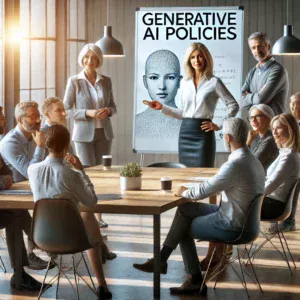Generative AI (GAI) has the potential to reshape the way social housing boards operate, but for leaders like David, the chair of a mid-sized social housing board, it’s a new frontier. David’s story highlights his journey from scepticism to embracing AI, illustrating how this technology can enhance board governance, tenant engagement, and decision-making in social housing.
Meet David: A Chair with a Mission
David has always been dedicated to his role as chair of his social housing board. He prioritises tangible, people-focused actions over technology, and while he’s open-minded, he’s also cautious. Like many board members, David isn’t easily swayed by flashy tech. His concern is whether a tool like AI can truly serve the needs of the community he cares about so deeply.
However, after attending a recent social housing conference where AI’s potential was discussed, David’s curiosity was piqued. One of his fellow board members recommended a guide called Scepticism to Success: A Board Member’s Guide to Gen AI. And that’s where David’s journey with AI began.
A Simple Guide Demystifies AI for David
David wasn’t expecting much when he opened the guide. After all, AI felt like something only tech experts could understand. But what he found surprised him. The guide broke down AI into simple, clear language that made sense. It wasn’t filled with jargon or tech-speak but instead offered practical examples of how AI could be used in social housing governance.
For David, the key was how the guide connected AI to real-world applications—ways to streamline processes, enhance decision-making, and improve tenant engagement. He could now see AI as more than just a trend. It was a tool that could support his board’s efforts in delivering value to tenants and the community.
The Power of Generative AI for Board Members

David’s journey with AI started with simple applications. The guide showed him how AI could tackle everyday tasks that often took up valuable time. Here are a few ways AI helped David and his board:
1. Automated Meeting Scheduling
One of the first things David implemented was an AI tool to automate meeting scheduling. Instead of the endless back-and-forth emails trying to find a suitable time, the AI analysed board members’ calendars and scheduled meetings when everyone was available. The tool saved time and ensured that meetings were set up efficiently.
2. Document Management Made Easy
David also implemented AI to handle document management. With AI, board reports were categorised, summarised, and easily accessible. This made it quicker for David and his team to prepare for meetings, cutting down hours of manual searching and reading. Everyone came to meetings better informed, allowing for more focused and productive discussions.
3. Instant Transcription for Board Meetings
Another game-changer for David was using AI to transcribe board meetings. AI-generated transcripts meant that minutes and action items were available promptly, ensuring nothing was missed. Board members could quickly review discussions and decisions without waiting for traditional minutes to be typed up.
Using AI for Strategic Insights
As David became more comfortable with AI, he started exploring how it could help with bigger-picture tasks. For example:
4. Analysing Tenant Feedback
AI tools helped David’s board analyse tenant feedback at scale. Instead of manually going through hundreds of comments, AI could aggregate and summarise key themes. This allowed the board to identify trends and address tenant concerns more proactively. With AI, the board was able to better tailor services to meet the needs of their community.
5. Summarising Regulatory Changes
Keeping up with regulatory changes is a significant challenge for any board. AI came to the rescue by summarising hundreds of pages of new regulations into concise reports. David and his team could easily digest the most important changes and their implications for the board without sifting through overwhelming documentation.
Workshops: Empowering the Board with AI

Realising that his entire board could benefit from these insights, David organised a series of AI workshops. Facilitated by the guide’s author, these workshops focused on the practical applications of AI for social housing boards. They walked through hands-on examples, showing how AI could assist with everything from tenant communication to financial analysis.
The workshops helped the board see the value of AI firsthand. They were no longer intimidated by the technology. Instead, they embraced it as a tool that could make their jobs easier and improve how they served their tenants.
Tangible Benefits for David’s Board
After implementing AI tools and processes, David’s board saw immediate benefits:
Improved Efficiency: Tasks that used to take hours—like scheduling, document preparation, and meeting minutes—were now done in minutes, giving the board more time to focus on strategic issues.
Enhanced Decision-Making: AI-powered data analysis provided insights into financial trends, tenant feedback, and housing regulations, allowing for more informed decisions.
Better Tenant Engagement: With AI tools analysing feedback and generating customised communications, tenants felt more heard and engaged with the board.
David’s Reflections on AI
Over coffee with his vice-chair, David reflected on how much his mindset had shifted. Initially sceptical about AI, he realised that his board was now operating more efficiently than ever. More importantly, AI had not replaced the human touch that David valued—it had enhanced it. By taking care of time-consuming tasks, AI allowed the board to focus on the things that truly mattered: their tenants and the community.
Lessons from David’s Journey
What can other board members learn from David’s journey? Here are a few takeaways:
1. Embrace Change.AI might seem daunting at first, but by starting small and focusing on practical applications, board members can experience its benefits without feeling overwhelmed.
2. Collaboration is Key. For AI to succeed in board governance, it requires buy-in from the whole team. Collaboration and open-mindedness are essential for integrating new technologies effectively.
3. Continuous Learning. The world of AI is constantly evolving. David realised the importance of staying informed about new developments and tools that could further enhance board operations.
4. Keep it Human. AI is a tool, not a replacement for human judgment. It should support, not overshadow, the personal insights and relationships that are critical in social housing governance.
Conclusion: David’s AI Success Story
David’s journey from sceptic to advocate for AI in social housing governance demonstrates how technology can enhance boardroom processes without losing sight of the human element. By embracing AI, David and his board have become more efficient, informed, and more engaged with their community.
AI is not just a trend; it’s a tool that when used thoughtfully, can transform how boards operate and improve the lives of those they serve.
For more information as to how AI can help board governance download our guide Scepticism to Success: A Board Member’s Guide to Gen AI.
or try our blogs on For more reading try our blog on David’s AI Journey: Curated Insights for Social Housing Boards or How Gen AI Can Help (& Hinder) Boards






